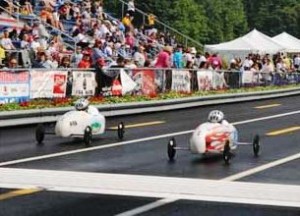More than 500 kids and their families will be in Akron, Ohio for a week of activities leading up to the 73rd All-American Soap Box Derby, which will run at Derby Downs on Saturday, July 24.
Children between the ages of eight and 17 earned the trip to Akron by winning a local Soap Box Derby competition in their “gravity-powered” race cars.
They will come from 40 U.S. states, as well as Canada, Germany, New Zealand, Japan and Guam, according to the race organizers.
The Derby, with some bombast, has been called “The Greatest Amateur Racing Event in the World.” No great matter – to the more than a million youngsters who’ve participated, it’s just the Soap Box Derby.
The Derby, however you know it, started in 1933, when a Dayton Daily News photographer came upon three boys racing home-made, engine-less cars down an inclined brick street. Myron E. Scott was known at the News for his creative thinking. “Why not hold a coasting race and award a prize to the winner?” Scottie thought.
He told the boys to come back to the same hill with their friends a week later, and they could participate in a race with a “loving cup”- as it was called in Depression era America – as a prize.
Nineteen boys arrived at the site in suburban Dayton to race. One of the cars – it lost – was said to represent Scottie’s vision of a Soap Box Derby racer – a hand built black racer with a big white “7” on it.
The car was built by Robert Gravett, son of a Dayton metal stamping plant employee. Scottie got his pictures, and “Old Number 7,” as he dubbed it, would become the symbol of the Derby for the next thirty-five years.
Ultimately, the race migrated to Akron then the center of U.S. Tire production. Derby Downs, said to be the first racing complex of its kind, was approved by the Works Project Administration and constructed in a city park near the Akron Municipal Airport. Alongside it was the Goodyear Air Dock where the blimps Macon and Akron were then housed.
The 1600-foot cement-paved raceway was divided into three lanes each ten feet wide. The actual racing distance was 1175 feet with several hundred feet of pavement above and below the course. An extra 200 unpaved feet at the foot of the track extended the run out area.

